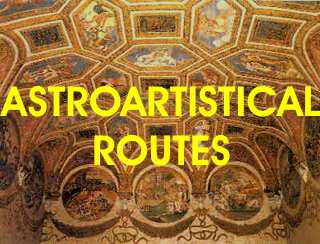

|
|
|
|
|
From
Vasari to Raffaello
The bond between the art and the sky observation, of the celestial bodies which fill it in and their influences on the life of the man, it's established in remote epoch. In the Troy book, it comes so described the Achille's shield that was realized by Efesto: "and he did as first a great and heavy shield adorning it everywhere; an edge he made in it, shiny, triple, sparkling, and a silver shoulder belt. They were five zones in the shield, and in it he made many ornaments with his wise thoughts. He made in it the earth, the sky and the sea, the tireless sun and the full moon and all those signs that crown the sky, the Pleiadis, the Iadi and the strength of Orion and the Ursa that they call with the name of the Charriot: it turns above itself and it looks at Orion, and alone it doesn't have part of the Ocean levacris." We can affirm then that the most ancient work of art with a representation of the sky and its constellations is attributable to the time of the Dčis, to the God Efesto. Even the human body became an astrological map with the diffusion, since the 12th century, of the "Melothesia", an encoded doctrine in Roman epoch from Manilio: to every part of the body it was the correspondance with a zodiacal sign; the astrological medicine pointed out therefore the predisposition toward the determination of the illnesses indicated by the sign of birth, avoiding to operate if the Moon were in the same sign corresponding to the sick orga and choosing the cares among the grasses dominated by that sign. Art, mirror of culture, reflected this branched penetration of the astrological wisdom in the western thought, with a proliferation of images, situated in Churches, in buildings of court, in the Pontifical ones. From the Middle Ages to the Renaissance it was realized in Italy a notable series of astrological cycles, with different kinds of characteristics: calendar give structures, with the association of the zodiacal signs to every month of the year, to the exposures of the influences of the Planets and the signs on the activities of the man; from the celestial maps, to the representations of the mythological origins of the constellations. The greatest complexity finds in the cycles in which a horoscope is represented: it deals with the particular situation of the sky in correspondence of important events or during the birth (the parentage) of the buyer. The powerful persons of the Renaissance as the Roman emperors, affirmed the inevitability of their glory through the theme of their parentage. Cosimo the Old man made to fresco a horoscope in the St. Lorenzo's Old sacristy; and after him the whole Medici family interested into astrology and submitted a long series of cycles to great artists: from Luca Della Robbia to Vasari, to the Bronzino. The powerful Siena's banker Agostino Chigi made to realize his own horoscope to the Farnesina from Baldassarre Peruzzi, submitting then the decoration to Raffaello with astrological theme of his own funeral chapel. The same Raffaello painted, on application of Giulio II, the situation of the sky during his election to the papacy, in the room of the Marking in Vatican. The decorations of the vatican apartments reflect in unequivocal way the complex cultural reality of the epoch: in the apartments of Alexander VI Borgia, Pinturicchio illustrated the influences of the planets on the activities and the character of theirs "children"; in the room of the Pontiffs, Giovanni from Udine and Perin del Vaga painted on commission of Leone X Medici, the popes' images close to those of the constellations; on the Five hundred foreshortening, Gregorio XIII made then to decorate the top of the room in Bologna with one detailed celestial map. It will only be with the end of Five hundred that its "erudite superstitio" (as the astrology was defined by the Cumont) will be forgotten: in the following centuries the astrological themes will return on the tops or on the walls of the buildings, but reduced to purely decorative motives.
|